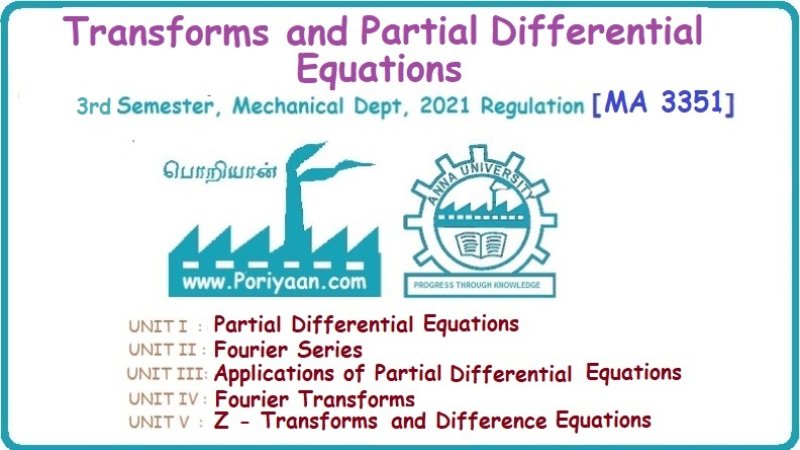Transforms and Partial Differential Equations: Unit IV: Fourier Transforms
Questions and Answers
Fourier Transforms | Transforms and Partial Differential Equations
Questions and Answers - Fourier Transforms - Transforms and Partial Differential Equations
PART-A QUESTIONS AND ANSWERS 1. State Fourier integral theorem. See Page 4.1 2. Show that f(x) = 1, 0 < x < ∞ cannot be represented by a Fourier integral. Sol: 3. Define Fourier Transform pair. (OR) Define Fourier Transform and its inverse transform. See Page 4.25 4. What is the Fourier cosine transform of a function ? See Page 4.78 5. Find the Fourier cosine transform of See Page 4.87 6. Find the Fourier cosine transform of e-ax , a > 0 See Page 4.89 7. Find Fourier Cosine transform of e-x Solution: 8. Find the Fourier sine transform of e-3x. Solution : 9. Find the Fourier sine transform of 3e-2x. Solution : 10. Find the Fourier Sine transform of 1/x See Page 4.107 11. Define Fourier sine transform and its inversion formula. See Page 4.80 12. Find the Fourier sine transform of f(x) = e-ax, a>0 and deduce that See Page 4.112 13. If Fourier Transform of f (x) = F (s), then what is Fourier Transform of f (ax)? See Page 4.27 14. If F denotes the Fourier Transform operator, then show that Solution : Differentiating both sides n times w.r.t. 's', we get Similarly, we can prove Similarly, we get 15. If Fourier transform of f (x) is F(s), prove that the Fourier transform of f(x) cos ax is 1/2 (F (s − a) + F (s + a)] See Page 4.29 16. Prove that See Page 4.82 17. If F(s) is the Fourier transform of f(x), then show that the Fourier transform of eiax f(x) is F(s+a). See Page 4.28 18. Given that (ii) Fourier cosine transform of Solution: 19. If F (s) is the Fourier transform of f(x), then find the Fourier transform of f (x − a). See Page 4.28 20. State the convolution theorem for Fourier transforms. Solution: Convolution theorem (or) Faltung theorem : If F(s) and G(s) are the Fourier transform of f(x) and g(x) respectively, then the Fourier transform of the convolution of f(x) and g(x) is the product of their Fourier transform. F [f(x) * g(x)] = F(S) G(S) = F [f(x)] F [g(x)] 21. State the Fourier transform of the derivatives of a function. See Page 4.30, Q.No. 6. (i) and (ii) 22. Find the Fourier sine transform of f (x) = e-x. Solution : 23. Give a function which is self reciprocal under Fourier sine and cosine transforms. Solution: 24. State the modulation theorem in Fourier Transform. See Page 4.29 25. State the Parseval's identity on Fourier Transform. See Page 4.34 26. Define self reciprocal with respect to Fourier transform. See Page No. 4.38 27. Does Fourier Sine transform of ƒ (x) = k, 0 ≤ x < ∞, exist? Justify your answer. Solution: Given: f(x) = k, 0 ≤ x < ∞ We know that, Since, cos∞ is undefined. 28. State the condition for the existence of Fourier cosine and sine transform of derivatives. Solution : Let f (x) be continuous and absolutely integrable on the x-axis, Let f'(x) be piecewise continuous on finite interval, and let f (x) → 0 as x → ∞ then 


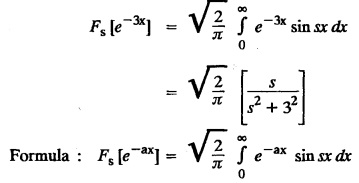
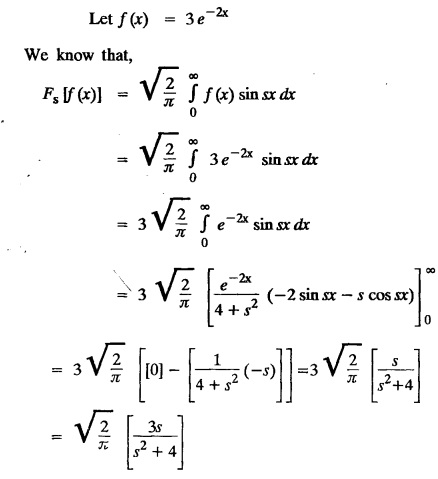






 where Fc denotes the Fourier cosine transform f(x).
where Fc denotes the Fourier cosine transform f(x). is self reciprocal under Fourier cosine transform, find (i) Fourier sine transform of
is self reciprocal under Fourier cosine transform, find (i) Fourier sine transform of  and
and
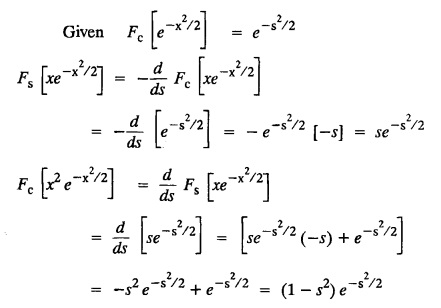


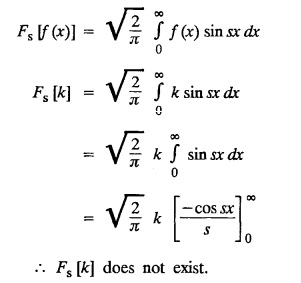
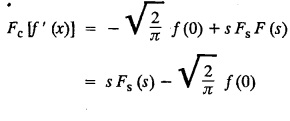
Transforms and Partial Differential Equations: Unit IV: Fourier Transforms : Tag: : Fourier Transforms | Transforms and Partial Differential Equations - Questions and Answers
Related Topics
Related Subjects
Transforms and Partial Differential Equations
MA3351 3rd semester civil, Mechanical Dept | 2021 Regulation | 3rd Semester Mechanical Dept 2021 Regulation
